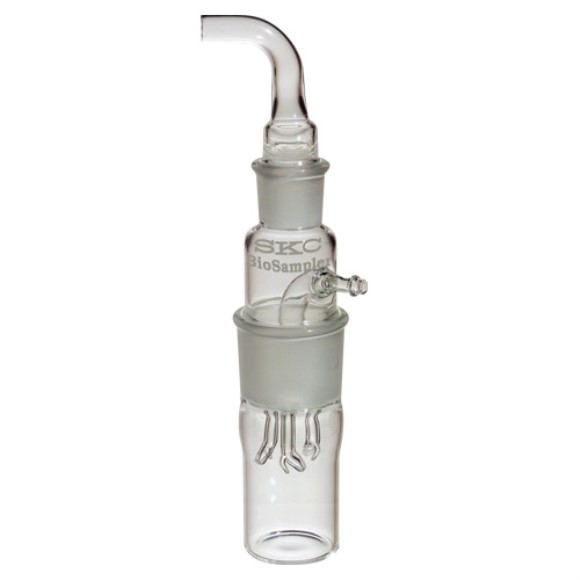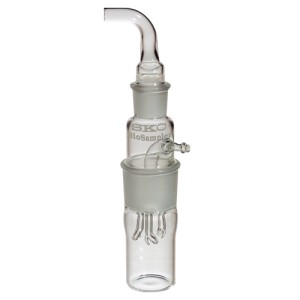SKC BioSampler for 8-hour Sampling of Bioaerosols into Liquid
Bioaerosols are airborne particles of biological origin (e.g., bacteria, fungi, pollen, viruses) and their by-products such as endotoxins or mycotoxins and other fragments. While there is no standardized method for bioaerosol collection at this time, many organizations, including SKC, are researching improved measurement techniques. The BioSampler is a result of SKC's work with leading scientists at the University of Cincinnati.
Sampling for Bioaerosols
Many of the same techniques that are used for non-biological aerosols can be used for bioaerosols. However, to properly evaluate bioaerosol samples, collection procedures must ensure the survival or biological activity of bioaerosol particles during and after collection.1 The BioSampler is highly effective at collecting viable samples.
The SKC BioSampler
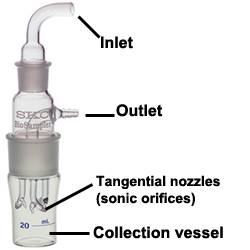
The BioSampler is a highly efficient glass collection device that requires a high-volume sonic flow pump to trap airborne microorganisms for subsequent analysis. Externally the BioSampler resembles an all-glass impinger such as the AGI-30.* Inside, it contains specific design features that overcome some of the sampling problems evidenced while using impingers for bioaerosol collection. The BioSampler's inlet design limits the collection of airborne particles to those that would pass through the human nose. The sampler is normally used with a liquid that swirls upward on the sampler's inner wall and removes collected particles.
The BioSampler can be used with non-evaporating collection liquids that have a viscosity much higher than water such as ViaTrap, a special mineral oil for sampling bioaerosols. When used with ViaTrap, the BioSampler's collection efficiency stays constant over an 8-hour sampling period. ViaTrap mineral oil may not be suitable for PCR analysis. The use of sterile water may be required.
| * |
All-glass Impinger (AGI-30) 30 refers to the distance in millimeters between the inlet stem or jet and the base of the impinger. |
Sampling with the BioSampler
The BioSampler must be operated with a sonic flow pump, such as the BioLite+ Sample Pump, that can maintain 15 inches mercury or 0.5 of an atmosphere of downstream pressure in the system. The BioSampler’s three tangential nozzles act as critical (sonic) orifices, each permitting 4.2 L/min of ambient air to pass through for a total flow rate of approximately 12.5 L/min.
Analysis Methods
BioSampler samples provide many analysis options. Contact a laboratory for collection liquid requirements. Visit www.skcinc.com/lab.
- Growth Culture Analysis quantifies and characterizes airborne cultural bacteria and fungi.
- Microscopic Analysis enumerates and provides limited identification of total airborne bacteria and fungi.
- Biochemical Assay quantifies biological compounds based on reaction to a chemical.
- Immunoassay quantifies airborne allergens based on antibodies binding to a specific target antigen.
- Polymerase Chain Reaction (PCR) identifies bioaerosols by screening for a specific genus or species.
Advantages of the BioSampler
There are many advantages to using the unique BioSampler in place of a standard impinger.
Greater Sampling Efficiency Over Longer Sampling Times
The BioSampler provides greater efficiency over longer sampling times because it can be used with non-evaporating liquids that have viscosities higher than water. Sample efficiently over an 8-hour workshift with the BioSampler using ViaTrap mineral oil. ViaTrap mineral oil may not be suitable for PCR analysis. Typical sampling times with standard impingers and impinger liquids are only 1 to 1.5 hours. The BioSampler's longer sampling times also provide increased sample volumes for detecting organisms at lower concentration levels.
Less Particle Bounce
The BioSampler's nozzles eject particles at an angle to the sampler's inner wall significantly reducing particle bounce and preserving aggregates of organisms. In standard impingers, microorganisms are typically damaged from collision with the impinger base plate.
Decreased Particle Re-aerosolization
The BioSampler nozzles also create a swirling airflow that maintains microorganism viability by gently moving particles into the collection surface without re-aerosolization. The collection liquid in standard impingers tends to bubble violently, causing collected particles to become re-aerosolized.
Performance Criteria
Although the topic of much discussion, no performance criteria for bioaerosol sampling have been adopted at this time (i.e., experimentally determined values to assess the suitability of a collection method for a specific application).4
Two performance characteristics are critical when choosing a bioaerosol sampler:
- Physical Collection Efficiency including the sampler's ability to aspirate airborne microorganisms into its inlet and to remove particles from the airstream and transfer them to the collection medium
- Biological Collection Efficiency referring to the sampler's ability to maintain viability or biological activity during sampling
Figure 1. (click to enlarge)
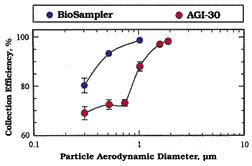 |
Test particle: PSL (Polystyrene Latex Beads)
Collection fluid: 20 ml deionized water
Sampling flow rate: 12.5 L/min BioSampler Collection Efficiency
|
Complete BioSampler Systems 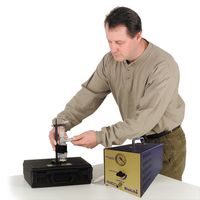
These turnkey sampling systems makes bioaerosol sampling easy. The Deluxe kit features one BioSampler for the efficient collection of airborne microorganisms, two additional 20-ml collection vessels (bottoms) with caps for sending samples to a laboratory, a case with mounting rod for securing the BioSampler during sampling, ViaTrap* (an efficient collection medium for sampling over an 8-hour period), and BioLite+ sample pump (vacuum-type, sonic flow) mounted in a protective housing with handle. The BioLite+ features a vacuum gauge to indicate sonic flow and a valve to adjust flow.
* ViaTrap mineral oil may not be suitable for PCR analysis.
References
- Nevalainen, A., Willeke K., Liebhaber F., Pastuszka J., Burge H., and Henningson E., "Bioaerosol Sampling: Aerosol Measurement Principles, Techniques, and Applications," Van Nostrand Reinhold, New York, 1993, pp. 471-492
- Lin, X., Willeke, K., Ulevicius, V., Grinshpun, S.A., "Effect of Sampling Time on the Collection of All-Glass Impingers," Am. Ind. Hyg. Assoc. Journal, v. 58, 1997, pp. 480-488
- Macher, J.M., Chatigny M.A., and Burge H.A., "Sampling Airborne Microorganisms and Aeroallergens," Air Sampling Instruments for Evaluation of Atmospheric Contaminants, 8th ed., ACGIH, Cincinnati, Ohio, 1995, pp. 589-617
- Macher, J.M., "Evaluation of Bioaerosol Sampler Performance," Applied Occupational Environmental Hygiene, v. 12, 1997, pp. 732-738
- Buttner, M.P., Willeke K., Grinshpun S.A., "Sampling and Analysis of Airborne Microorganisms," Manual of Environmental Microbiology, ASM Press, Washington, DC, 1997, pp. 629-640
- Willeke, K. Lin, X, Grinshpun, S.A., "Improved Aerosol Collection by Combined Impaction and Centrifugal Motion," Aerosol Science and Technology. 28:439-456 (1998)
- Lin, X, Reponen, T.A., Willeke K., Grinshpun S.A., Foarde, K., Ensor, D., "Long-term Sampling of Airborne Bacteria and Fungi into a Non-evaporating Liquid," Atmospheric Environment 33:4293-4298 (1999)
- Lin, X, Reponen, T., Willeke K., Wang, Z., Grinshpun S.A., Trunov, M., "Survival of Airborne Microorganisms during Swirling Aerosol Collection." Aerosol Science and Technology 32:184-196 (2000)
- Rule, A. M., Kesavan, J., Schwab, K.J., and Buckley, T.J., "Application of Flow Cytometry for the Assessment of Preservation and Recovery Efficiency of Bioaerosol Samplers Spiked with Pantoea agglomerans," Environmental Science and Technology, 41 (7), 2007, pp. 2467-2472
- Dungan, R., and Leytem, A., "Recovery of Culturable Escherichia Coli O157:H7 During Operation of a Liquid-based Bioaerosol Sampler," Aerosol Science and Technology, 50:71-75 (2016)
For more information on bioaerosol sampling, order:
- "The Field Guide for the Determination of Biological Contaminants in Environmental Samples," American Industrial Hygiene Association (AIHA), 703-849-8888 or www.aiha.org
- "BioAerosols: Assessment and Control," American Conference of Governmental Industrial Hygienists (ACGIH), 513-742-6163 or www.acgih.org

